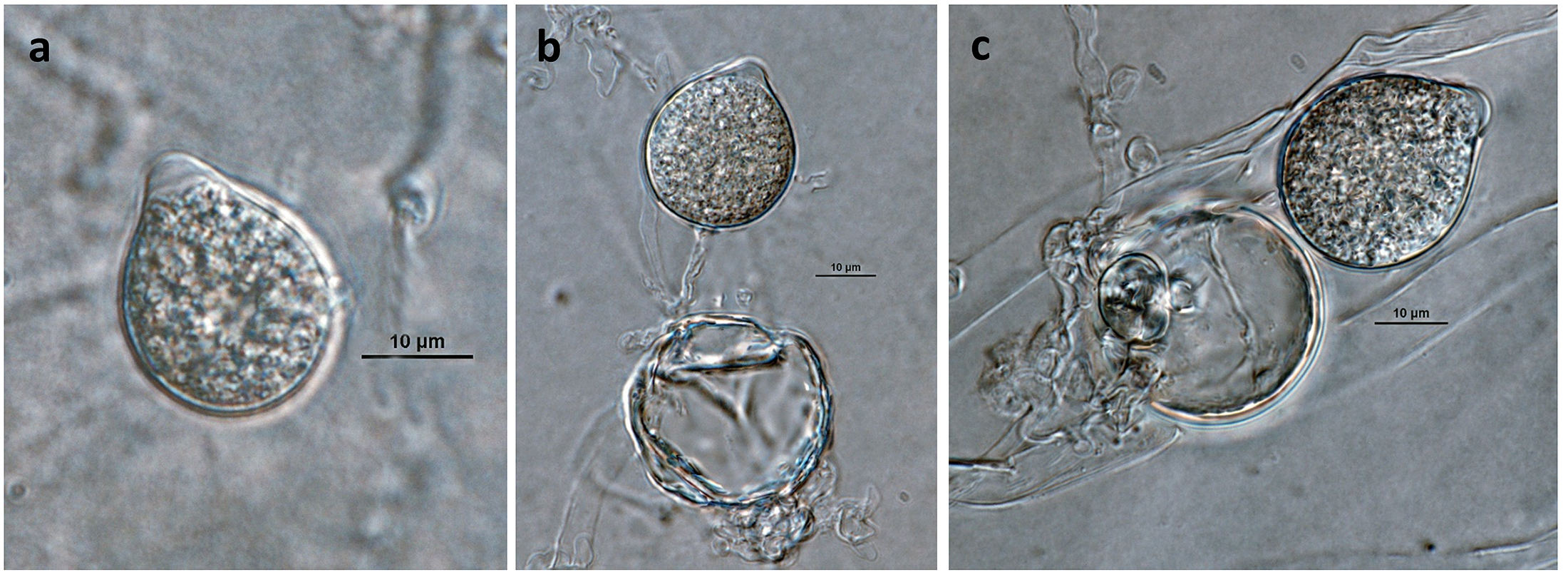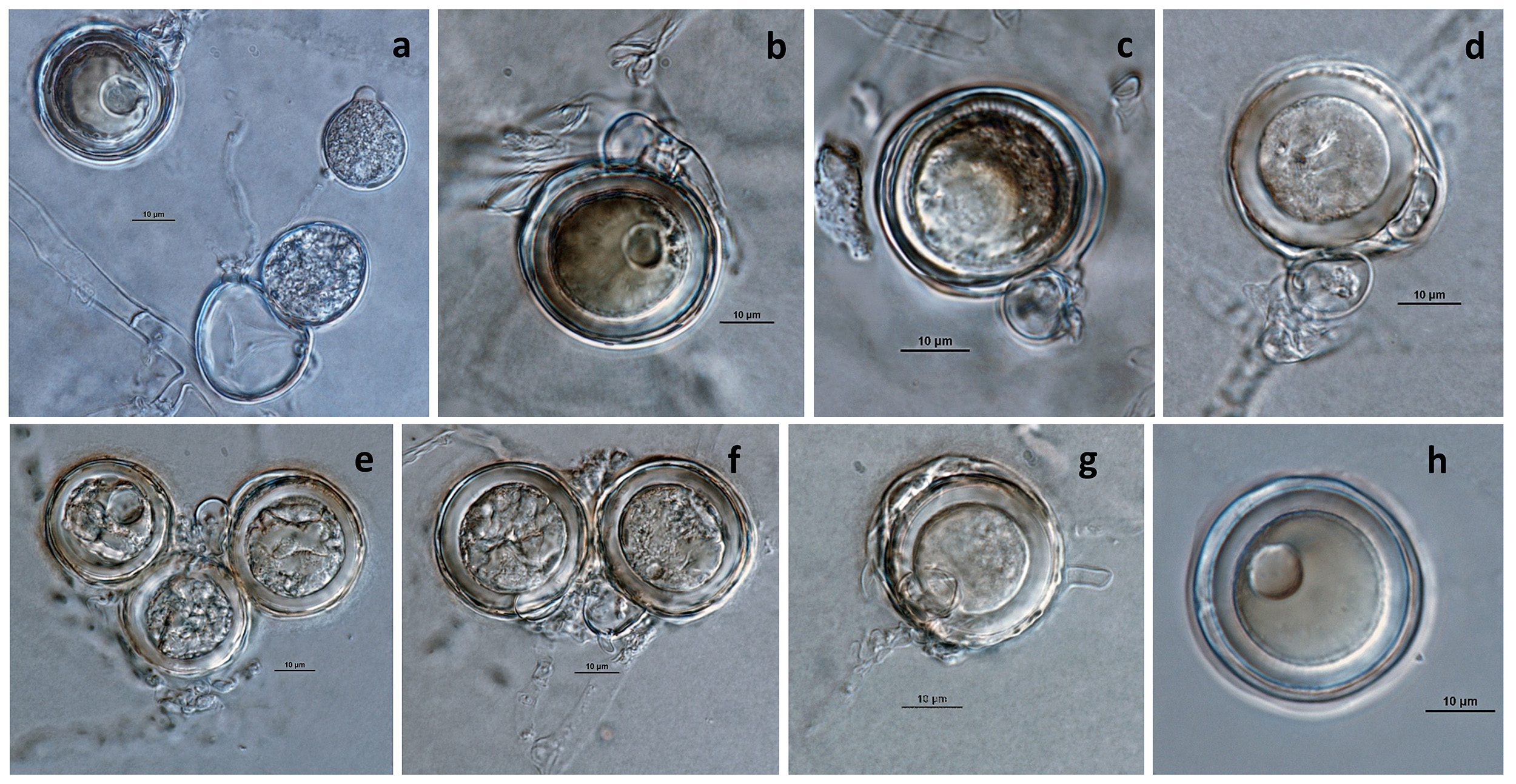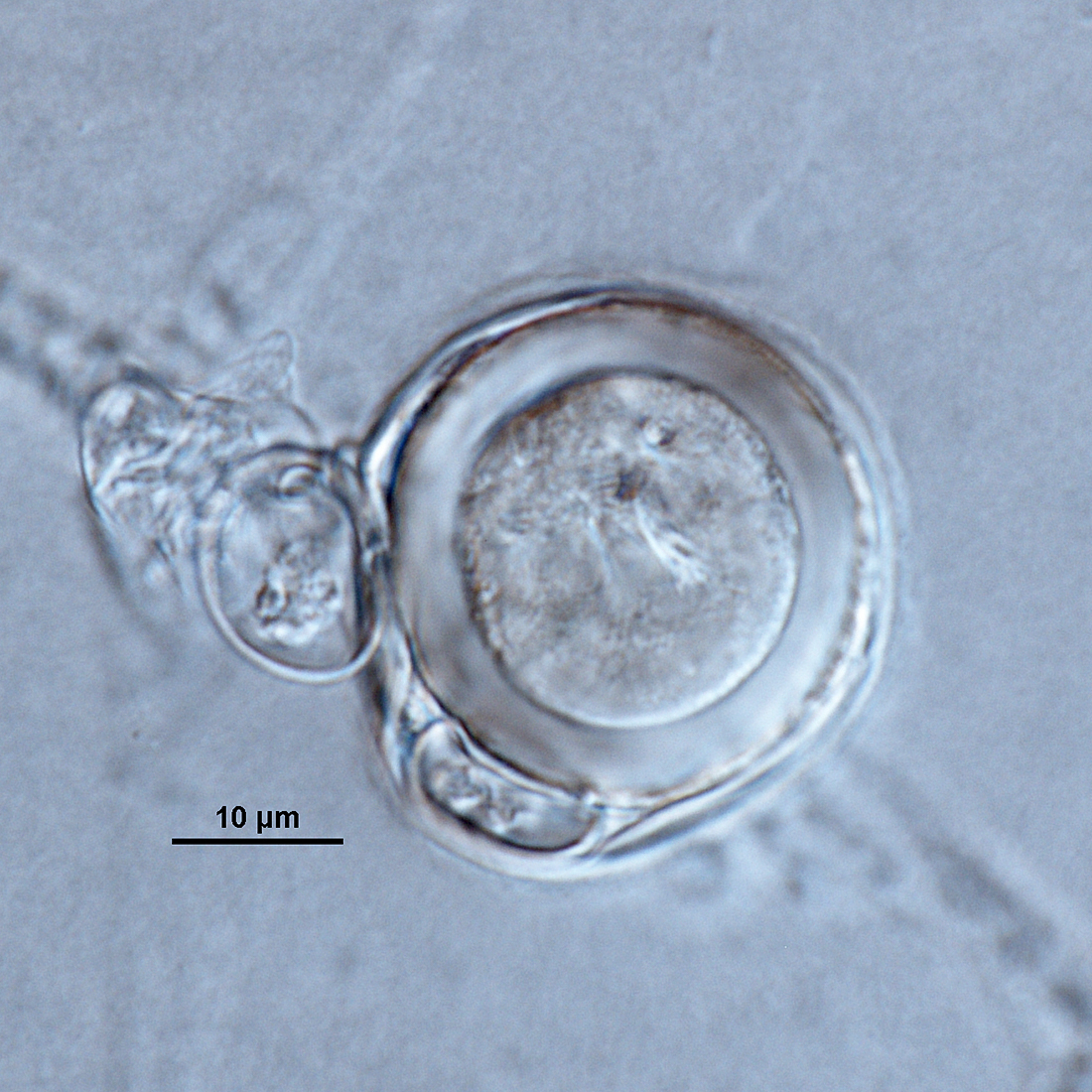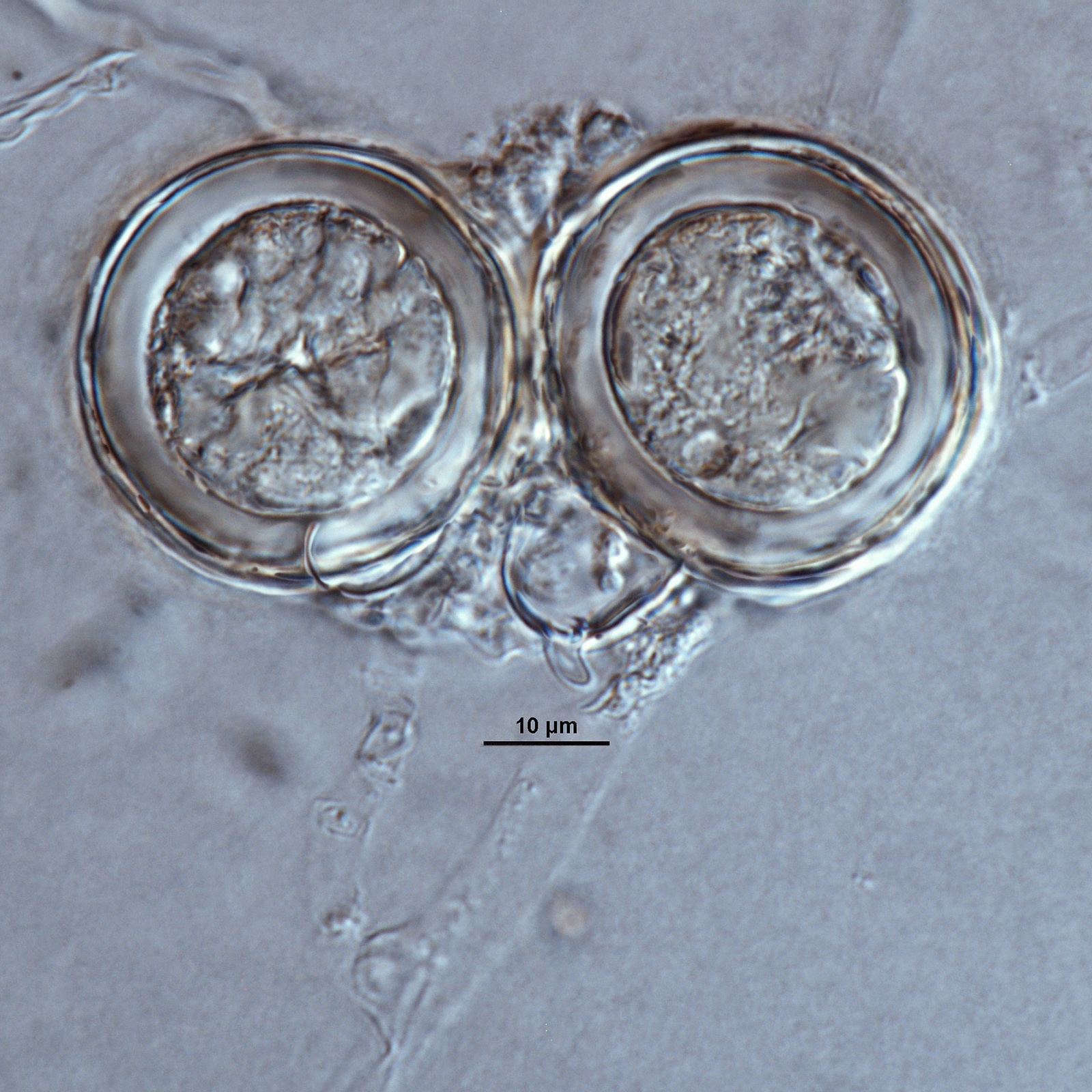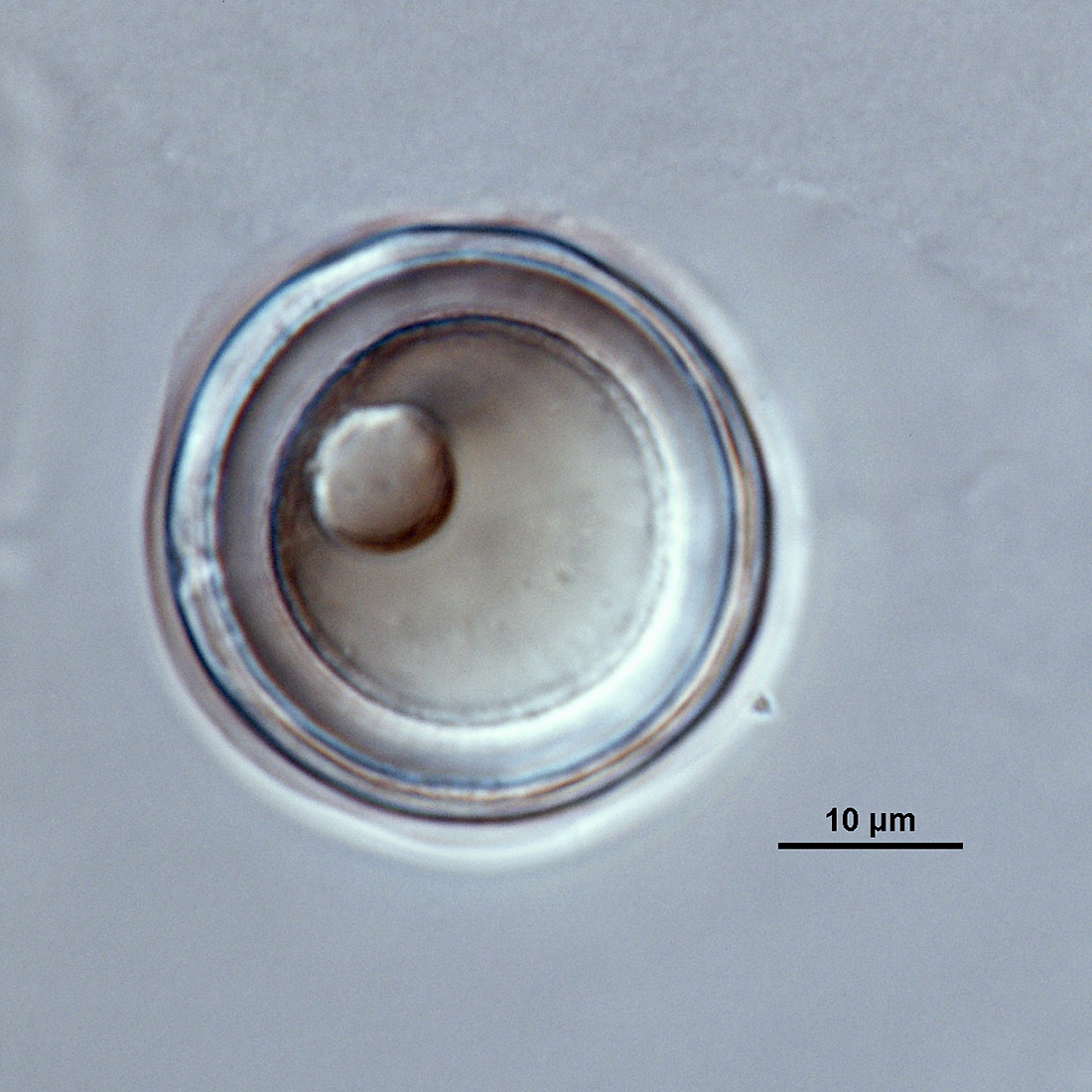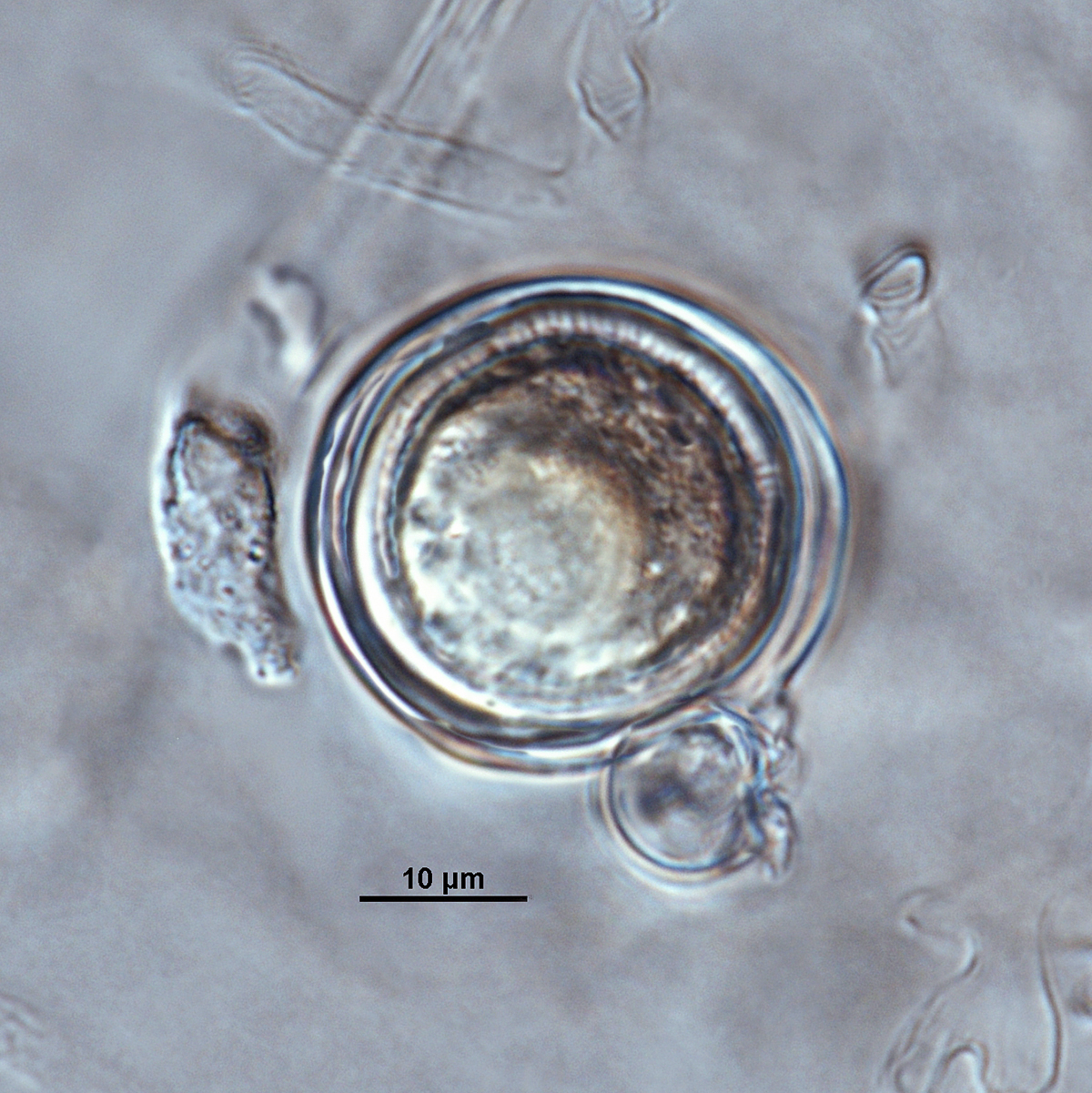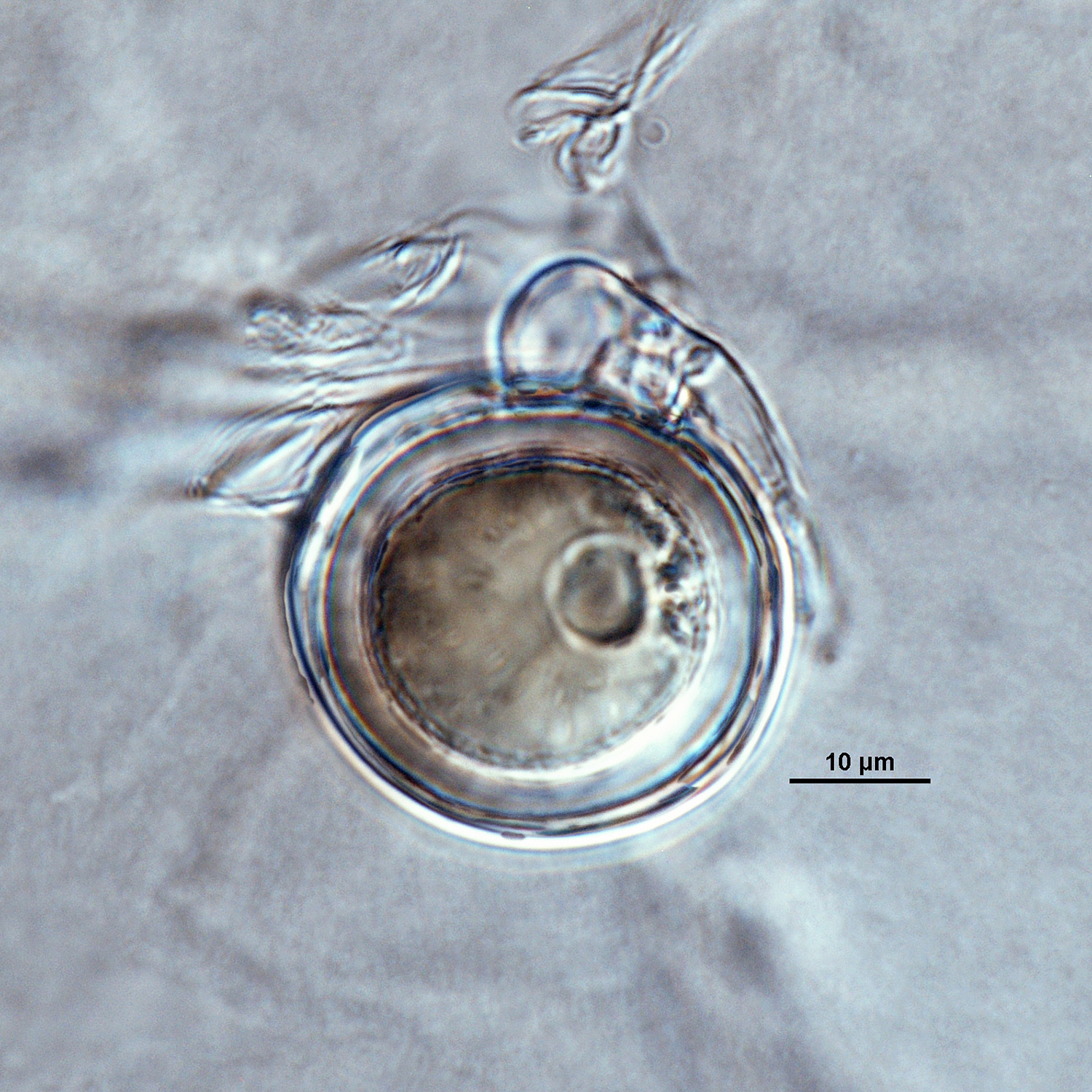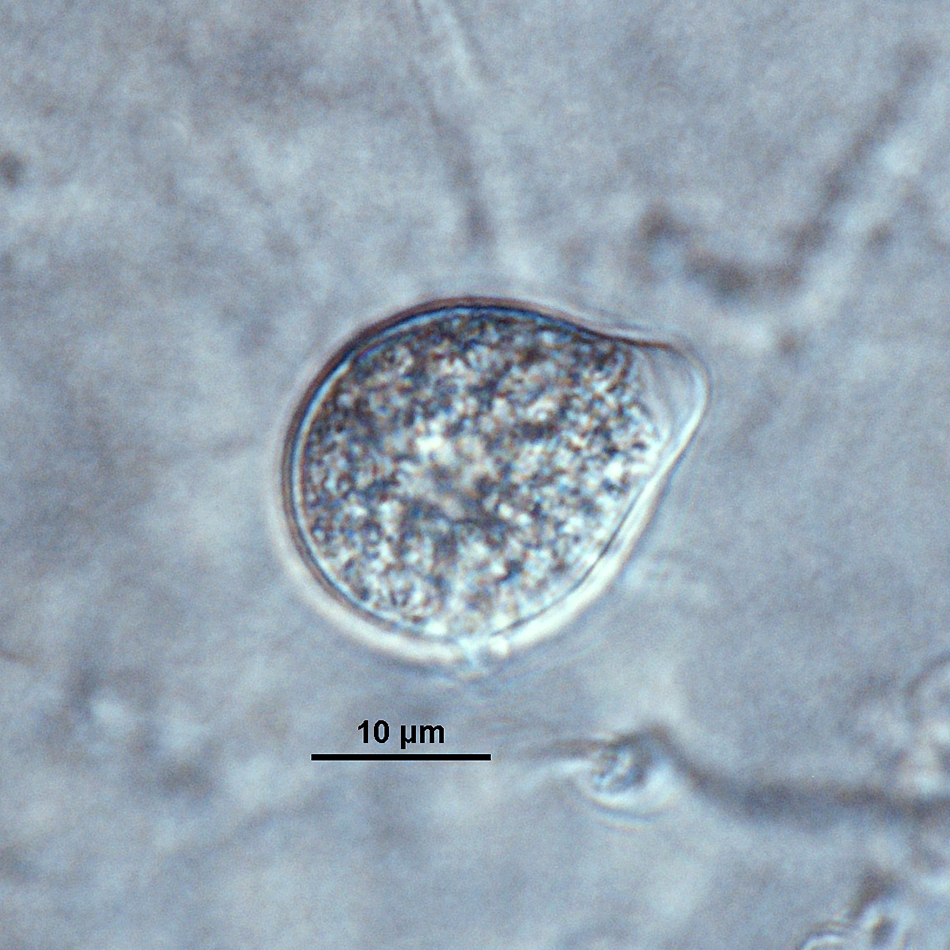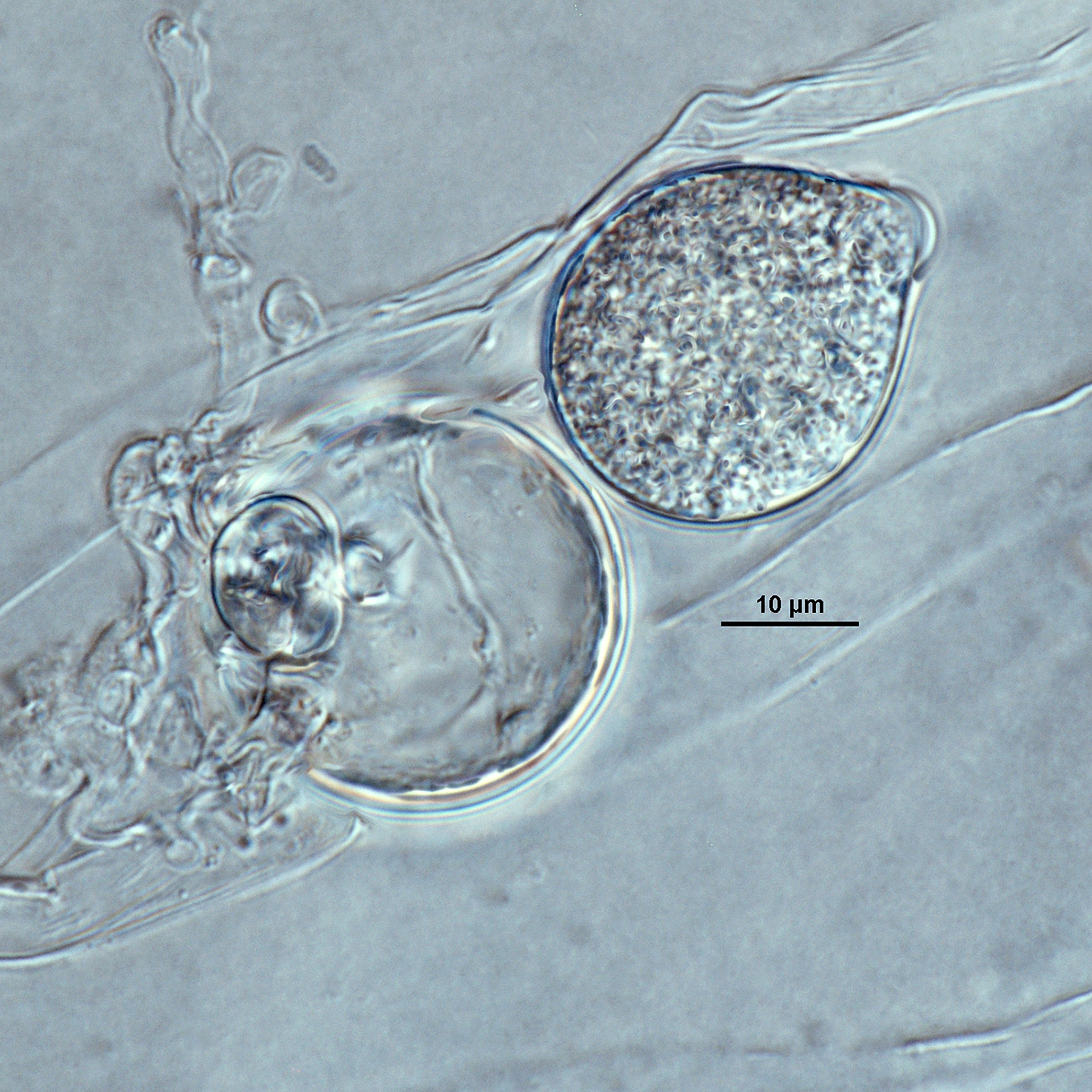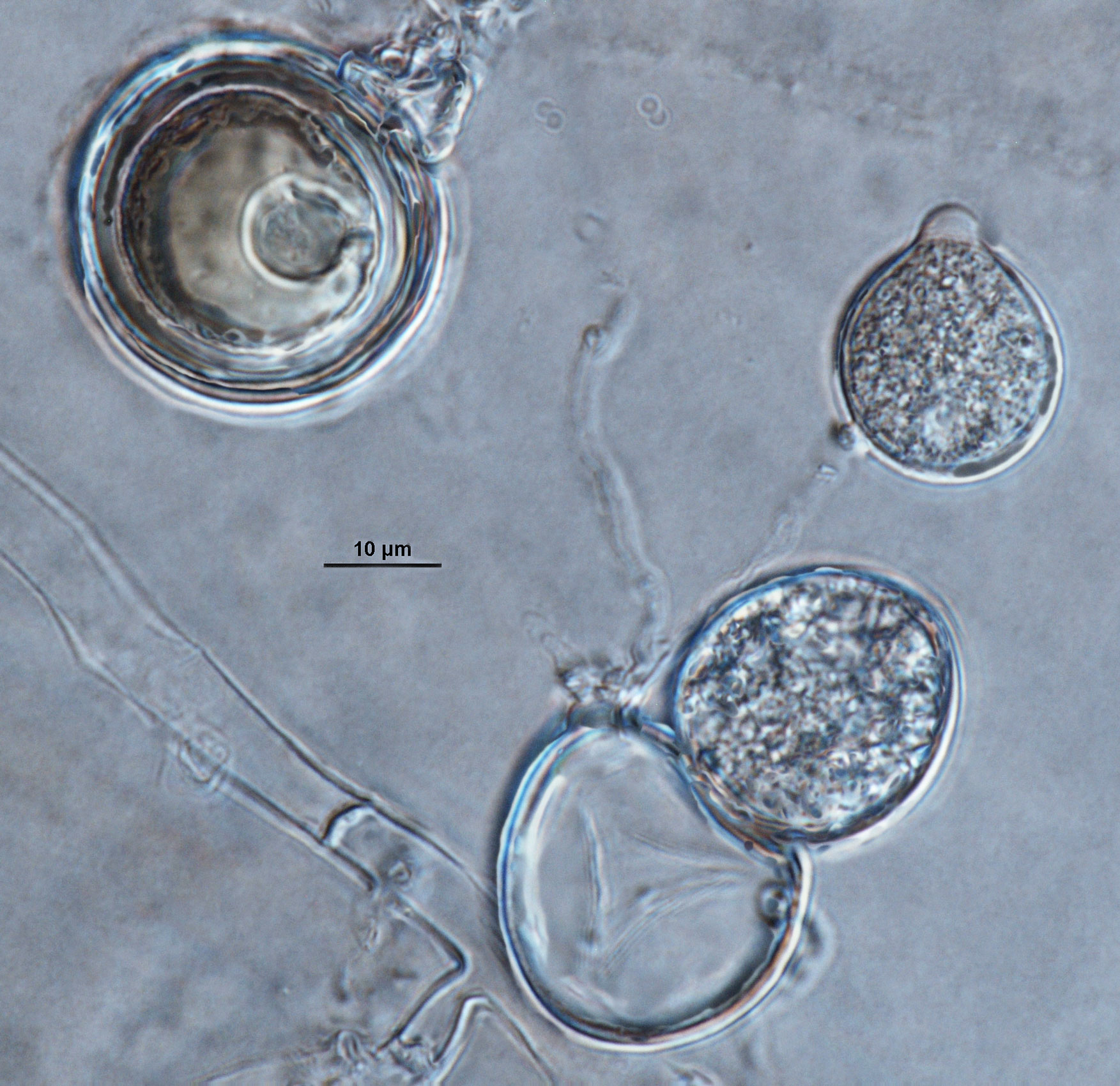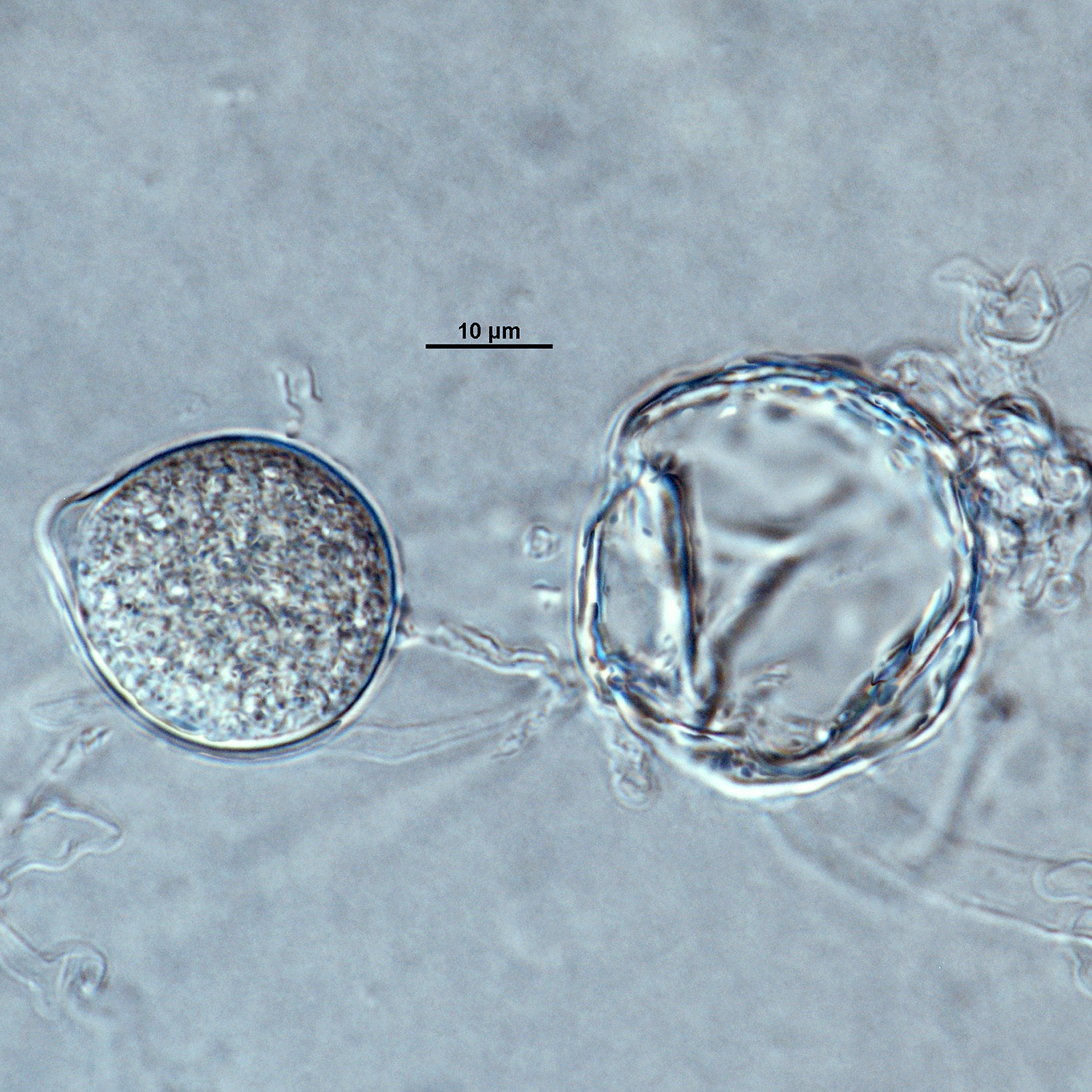Phytophthora occultans
|
Phytophthora spp. in subclade 2a: portion of the seven-loci ML phylogeny featuring the type cultures of 212 described species (by T. Bourret). Notice the position of P. occultans Ex-type CBS 101557 = S&T BL 163. Gloria Abad, USDA S&T.
|
|
Phytophthora spp. in subclade 2a: Morphological Tabular key (PDF) and Tabular key legends (PDF) in IDphy2 KEY SECTION. Notice the data of P. occultans Ex-type CBS 101557 = S&T BL 163. Gloria Abad, USDA S&T.
|
|
Phytophthora occultans (CPHST BL 163) colonies of the ex-type grown for 7 days on (a) V8® Agar, (b) potato dextrose agar, and (c) malt extract agar; photo by Clinton Greub, Krysta Jennings, and Leandra Knight, USDA-APHIS-PPQ |
|
Phytophthora occultans (ex-type CPHST BL 163) asexual phase: (a–c) semipapillate ovoid sporangia, (b, c) sporangia with sexual phase; photos by Gloria Abad, USDA-APHIS-PPQ. |
|
Phytophthora occultans (ex-type CPHST BL 163) sexual phase: (a) oogonium with amphigynous antheridium (rarely produced), (b–g) oogonia with paragynous antheridia (predominant), (e, f) plerotic oospores, (b–d, g, h) aplerotic oospores, (h) evanescent antheridium; photos by Gloria Abad, USDA-APHIS-PPQ. |
|
Phytophthora occultans (ex-type CPHST BL 163) sexual phase: oogonium with aplerotic oospore and predominantly paragynous antheridium; photo by Gloria Abad, USDA-APHIS-PPQ. |
|
Phytophthora occultans (ex-type CPHST BL 163) sexual phase: oogonia with plerotic oospores and predominantly paragynous antheridia; photo by Gloria Abad, USDA-APHIS-PPQ. |
|
Phytophthora occultans (ex-type CPHST BL 163) sexual phase: evanescent antheridium; photo by Gloria Abad, USDA-APHIS-PPQ. |
|
Phytophthora occultans (ex-type CPHST BL 163) sexual phase: oogonia with plerotic oospores and predominantly paragynous antheridia; photo by Gloria Abad, USDA-APHIS-PPQ. |
|
Phytophthora occultans (ex-type CPHST BL 163) sexual phase: oogonium with aplerotic oospore and predominantly paragynous antheridium; photo by Gloria Abad, USDA-APHIS-PPQ. |
|
Phytophthora occultans (ex-type CPHST BL 163) sexual phase: oogonium with plerotic oospore and predominantly paragynous antheridium; photo by Gloria Abad, USDA-APHIS-PPQ. |
|
Phytophthora occultans (ex-type CPHST BL 163) asexual phase: semipapillate ovoid sporangium; photo by Gloria Abad, USDA-APHIS-PPQ. |
|
Phytophthora occultans (ex-type CPHST BL 163) asexual and sexual phases: semipapillate ovoid sporangium and oospore; photo by Gloria Abad, USDA-APHIS-PPQ. |
|
Phytophthora occultans (ex-type CPHST BL 163) asexual and sexual phases: oogonium with amphigynous antheridium (rarely produced), and semipapillate sporangia; photo by Gloria Abad, USDA-APHIS-PPQ. |
|
Phytophthora occultans (ex-type CPHST BL 163) asexual and sexual phases: semipapillate ovoid sporangium and oospore; photo by Gloria Abad, USDA-APHIS-PPQ. |
Name and publication
Phytophthora occultans Man in 't Veld & K. Rosend. (2015)
Man In 't Veld WA, Rosendahl KC, van Rijswick PC, Meffert JP, Westenberg M, van de Vossenberg BT, Denton G, and van Kuik FA. 2015. Phytophthora terminalis sp. nov. and Phytophthora occultans sp. nov., two invasive pathogens of ornamental plants in Europe. Mycologia 107: 54–65.
Corresponding author: w.a.man.in.t.veld@minlnv.nl
Nomenclature
from Man In 't Veld et al. (2015)
Mycobank
Etymology
Occultare (L.), hiding. The species was found for the first time in 1998 in the Netherlands, then went unnoticed for more than 10 years, to re-emerge in 2010.
Typification
Type: NETHERLANDS, isolated from rotted roots of Buxus sempervirens, 1998, Wil Veenbaas (holotype CBS 101557, dried culture in herb CBS)
Ex-type: CBS 101557
Sequences for ex-type in original manuscript: ITS JX978155, CoxI JX978156, β-tub JX978157, TEF1a KF650770
Ex-type in other collections
(ET) CBS 101557, WPC P19955, S&T BL 163 (Abad), 65B9 (Hong)
Molecular identification
Voucher sequences for barcoding genes (ITS rDNA and COI) of the ex-type (see Molecular protocols page)
Phytophthora occultans isolate CPHST BL 163 (= P19955) ITS rDNA MG865555, COI MH477753
Voucher sequences for Molecular Toolbox with seven genes (ITS, β-tub, COI, EF1α, HSP90, L10, and YPT1
(see Molecular protocols page) (In Progress)
Voucher sequences for Metabarcoding High-throughput Sequencing (HTS) Technologies [Molecular Operational Taxonomic Unit (MOTU)]
(see Molecular protocols page) (In Progress)
Sequences with multiple genes for ex-type in other sources
- NCBI: Phytophthora occultans CPHST BL 163
- NCBI: Phytophthora occultans CBS 101557
- EPPO-Q-bank: Phytophthora occultans
- BOLDSYSTEMS: Phytophthora occultans (barcoding COI & ITS)
Position in multigenic phylogeny with 7 genes (ITS, β-tub, COI, EF1α, HSP90, L10, and YPT1)
Clade clade:
a taxonomic group of organisms classified together on the basis of homologous features traced to a common ancestor
2a
Morphological identification
adapted from Man In 't Veld et al. (2015)
Colonies and cardinal temperatures
Colony colony:
assemblage of hyphae which usually develops form a single source and grows in a coordinated way
after 7 days of growth on V-8 agar and malt extract agar with slightly stellate pattern, on potato dextrose agar with no distinctive pattern. Minimum growth temperature 10°C, optimum 25–27°C, and maximum 32°C.
Asexual phase
Sporangia semipapillate, sometimes bipapillate; caducouscaducous:
pertaining to sporangia that become dislodged readily (i.e. deciduous) and separate from the sporangiophore (cf. persistent)
with medium pedicelpedicel:
the hyphal base of a sporangium that remains attached after the sporangium separates, or is shed, from the sporangiophore; the pedicel may be short (< 5 µm), medium (5–20 µm), or long (> 20 µm)
(8–30 μm) and persistentpersistent:
pertaining to sporangia that remain attached to the sporangiophore and do not separate or detach easily (cf. caducous)
; ovoidovoid:
egg-shaped, with the widest part at the base of the sporangium and the narrow part at the apex
, obpyriformobpyriform:
inversely pear-shaped, i.e. with the widest part at the point of attachment (cf. pyriform)
, ellipsoidellipsoid:
refers to a solid body that forms an ellipse in the longitudinal plane and a circle in cross section; many fungal spores are ellipsoidal or elliptic
, sometimes with irregular shapes (mouse-shaped) (26–34 L × 40–55 W μm); originated on simple sympodial or branched sporangiophores. Hyphal swellings absent. ChlamydosporesChlamydospores:
an asexual spore with a thickened inner wall that is delimited from the mycelium by a septum; may be terminal or intercalary, and survives for long periods in soil
absent.
Sexual phase
Homothallic. Oogonia smooth-walled, globoseglobose:
having a rounded form resembling that of a sphere
(26–28 μm diam.); antheridiaantheridia:
the male gametangium; a multinucleate, swollen hyphal tip affixed firmly to the wall of the female gametangium (the oogonium)
predominantly paragynousparagynous:
pertaining to the sexual stage in which the antheridium is attached to the side of the oogonium (cf. amphigynous)
; oosporesoospores:
zygote or thick-walled spore that forms within the oogonium after fertilization by the antheridium; may be long-lived
pleroticplerotic:
pertaining to an oospore that fills the oogonium (cf. aplerotic)
rarely apleroticaplerotic:
pertaining to a mature oospore that does not fill the oogonium; i.e. there is room left between the oospore wall and oogonium wall (cf. plerotic)
(25–26 μm diam.).
Additional specimen(s) evaluated
Phytophthora occultans ex-type CPHST BL 163, duplicate of P19955 (World Phytophthora Collection), which is a duplicate of ex-type CBS 101557
Hosts and distribution
Distribution: Europe (Germany, Netherlands, Romania), North America (USA: OR)
Substrate: roots, collar
Disease note: wilting, stem lesions, root rot
Host: Ceanothus spp. (Rhamnaceae), Buxus sp. (Buxaceae), Rhododendron, Gaultheria shallon, Arctostaphylos uva-ursi (Ericaceae), Mahonia nervosa (Berberidaceae)
Retrieved January 31, 2018 from U.S. National Fungus Collections Nomenclature Database.
Additional references and links
- SMML USDA-ARS: Phytophthora occultans
- EPPO Global Database: Phytophthora occultans
- Forest Phytophthoras of the World: Phytophthora occultans
- CABI Digital Library: Phytophthora occultans
- Encyclopedia of Life (EOL): Phytophthora occultans
- Index Fungorum (IF): Phytophthora occultans
- Google All Phytophthora occultans
- Google Images Phytophthora occultans
- Google Scholar Phytophthora occultans
Fact sheet author
Z. Gloria Abad, Ph.D., USDA-APHIS-PPQ-S&T Plant Pathogen Confirmatory Diagnostics Laboratory (PPCDL), United States of America.


